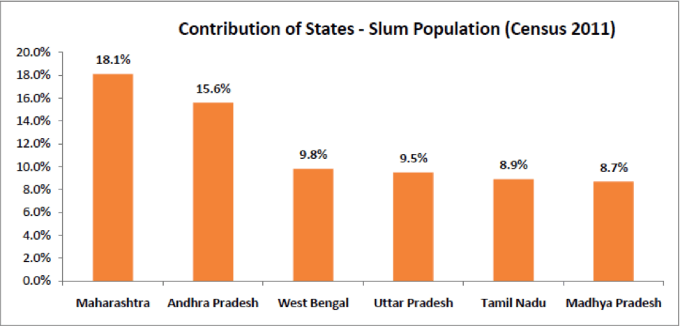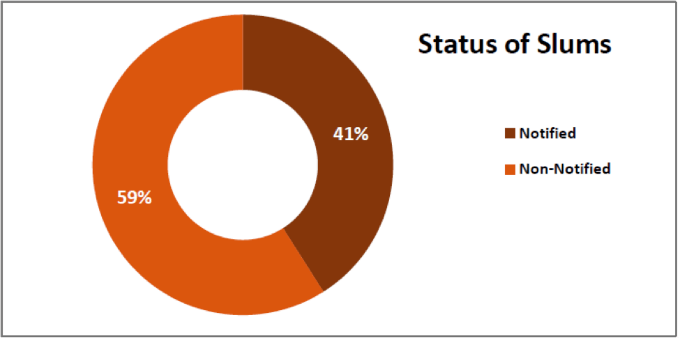[orc]Slums are a manifestation of Urban Poverty in our country. There has been a 25% rise in the slum population from 2001 to 2011. 70% of the slum population lives in 6 states with Maharashtra contributing 18% of the total slum population of the country. Slums lack a lot of facilities extended to other parts of urban settlements and that is evident from the data released by the 69th round survey of the NSSO.
Slums are the most visible manifestation of poverty in urban India. Slums are everywhere and yet they are nowhere; everywhere because of rapid urbanization and yet nowhere because they are mostly not notified. These informal settlements occupy one-third of the large city spaces. As per the 2001 census reports, 41.6% of the total slum population resides in cities with over one-million population.
The slum population in the country has increased from 5.23 crore in 2001 to 6.59 crore in 2011. This rapid growth is because of the following among other reasons.
- Increasing urbanization
- Migration leading to increase in urban poor population
- Limited availability of affordable housing
- Limited access to housing loan for urban poor
Six states contribute more than 70% of the total slum population in the country as per the 2011 Census.Maharashtra contributes more than 18% of the total slum population followed by Andhra Pradesh, West Bengal, Uttar Pradesh, Tamil Nadu & Madhya Pradesh.
But how are slums identified?
The Ministry of Statistics & Program Implementation (MoSPI) released the data for the 69th round survey of the National Sample Survey Office (NSSO) on Urban Slums in India. The data released included some key indicators.
Any compact settlement with a collection of poorly built tenements, mostly of temporary nature, crowded together, usually with inadequate sanitary and drinking water facilities in unhygienic conditions, provided at least 20 households lived there, is considered a slum. Such a settlement, if not a notified slum, is called a non-notified slum. Both notified slums i.e. areas notified as slums by the concerned municipalities, corporations, local bodies or development authorities and other slums are part of the above figures.
A total of 33,510 slums were estimated to be present in the urban areas of India. About 41% of these were notified and 59% non-notified.
What is the overall situation in these slums?
The data included key indicators on land, housing, drinking water, electricity, drainage, latrine, garbage etc.
- At all-India level 44% of slums (48% of notified slums and 41% of non-notified slums) were located on private land.
- In about 60% of all slums, the majority of houses had pucca structures. The proportion of such slums was 85% among notified slums but only 42% of non-notified slums.
- At the all-India level 71% of all slums had tap as major source of drinking water, the figure being 82% for notified slums but only 64% for non-notified slums.
- The phenomenon of absence of electricity in slums appeared to be largely confined to non-notified slums. At all-India level only 6.5% of all slums had no electricity, the corresponding figures being 11% for non-notified slums but only 0.1% for notified slums.
- In about 66% of all slums, the road used by the dwellers as main thoroughfare was a pucca road. The proportion was 83% for notified slums and 55% for non-notified slums.
- At the all-India level 31% of slums had no latrine facility, the figure being 42% for non-notified and 16% for notified slums.
- About 31% of all slums had no drainage facility, the figure being considerably higher for non-notified slums (45%) than for notified slums (11%).
- At the all-India level, 27% of all slums had no garbage disposal arrangement, the figures being about 38% for non-notified slums and about 11% for notified slums.
- In an estimated 32% of all slums, the approach road to the slum usually remained waterlogged due to rainfall. The figure was 35% for notified slums and 29% for non-notified slums.
- At the all-India level 24% of slums benefited from welfare schemes such as Jawaharlal Nehru National Urban Renewal Mission (JNNURM), Rajiv Awas Yojana (RAY), or any other scheme run by the Central Government or State Government or any local body. The proportion benefiting from such schemes was 32% among notified and 18% among non-notified slums.
Slum Rehabilitation
The Govt. is implementing Rajiv Awas Yojana (RAY) as a centrally sponsored scheme, for providing houses along with basic civil and social infrastructure for slum dwellers and urban poor. Under the scheme, government provides central assistance to the extent of 50% to 75% with cost upper ceiling depending upon size of city
The erstwhile National Advisory Council has stressed that slum dwellers should be resettled at the spot where they are currently living. The rehabilitation of slum dwellers is under way under the Ministry of Housing & Urban Poverty Alleviation.
Slum Facilities
- 66% households are having latrine facilities within the premises and 34% households have no latrine facility within the premises.
- More than 90% slum households use electricity as main source of lighting
- 74% households use tap water, 3% well water, 20.3% hand pump/tube well and 2.8% use other sources of drinking water
- 67% slum households have a bathroom, 15% have enclosures for bathing without roof and 19% slum households have no bathroom
The Reality Check
While many of the programs for Slum Dwellers are to be adopted by the state governments and designed to be facilitated by central governments, the reality is completely different. As per a planning commission study, almost 75% of slum households have not received any benefits from any of the governmental programmes designed to alleviate poverty.
The slums are not a manifestation of demographic shifts, but the result of the failure of land and housing policies, and of legal and delivery systems. The urban poor are trapped in an informal and illegal world of slums that are not reflected on maps, where waste is not collected, where taxes are not paid and where public services are not provided. Most of them officially do not exist.
Source:
- Answer to Unstarred Question No 383, answered on 25.02.2015, Ministry of Urban Development, Lok Sabha
- 69th round survey of the National Sample Survey Office (NSSO)
Featured Image: Flickr | Thomas Leuthard





2 Comments
Pingback: Slums are Everywhere, Yet Nowhere | The Inquisit
Pingback: Slums are Everywhere, Yet Nowhere – Factly – gsmaterials